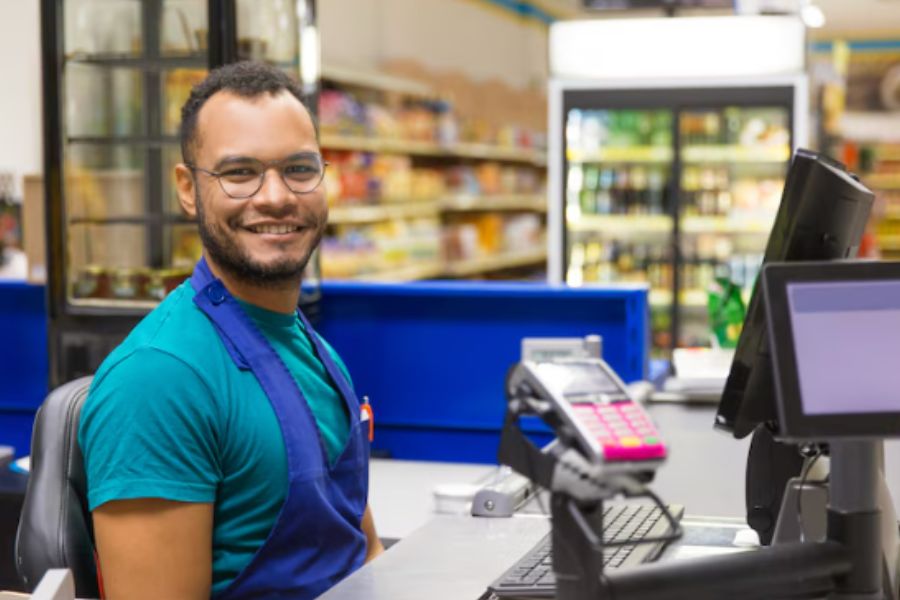Running a WooCommerce shop often means managing both an online and a physical store. While this approach helps reach a broader customer base and boosts conversion rates, it also brings inventory management challenges. Keeping stock levels synchronized across both sales channels can be complex and time-consuming. The best solution? WooCommerce POS integration. The connection of physical POS with WooCommerce shop, you can streamline operations, prevent stock discrepancies, and enhance the overall shopping experience.
In this article, we’ll explore the key benefits of using a POS system and provide a step-by-step guide on setting up WooCommerce POS integration. While the exact process may differ depending on the plugin you choose, the core setup remains the same.
Highlights:
- The connection process involves choosing a compatible WooCommerce POS plugin, installing and configuring it, syncing products and inventory, setting up payment methods, and managing orders seamlessly.
- The WooCommerce – physical POS integration keeps sales, stock, and customer data updated in real time, reducing errors and improving the shopping experience both online and in-store.
Why you need to connect physical POS with WooCommerce shop
WooCommerce led the global eCommerce software market in 2024 with a 39% share, surpassing Squarespace Online Stores (14.75%) and Woo Themes (13.96%). With such dominance, many businesses rely on WooCommerce for their online presence, but managing both online and offline sales can be challenging.
Keeping store operations smooth requires a system that syncs information without delays. Connecting a physical POS with WooCommerce shops helps maintain accurate stock levels, speed up order processing, and improve the shopping experience.
- The worldwide cost of inventory distortion – shrinkage, stockouts, and overstock – reaches $1.1 trillion. In-store sales must sync with inventory instantly to avoid overselling. If a product runs out at a retail location but still shows available online, customers may order items that no longer exist, leading to frustration and lost revenue. Automating updates between a POS and WooCommerce removes manual adjustments, cutting errors and keeping stock accurate across all channels.
- Tracking revenue, expenses, and stock movement becomes easier when both systems communicate. Instead of pulling data separately from different sources, store owners can access a unified view of sales performance. This allows better planning when it comes to restocking products, adjusting prices, and identifying trends.
- Payments processed through a POS should align with online transactions to avoid discrepancies. Customers who purchase in-store may later return or exchange items through the website. A connected system simplifies these transactions, keeping order histories accurate regardless of where the purchase was made.
- Retail staff can work more effectively when they don’t have to switch between separate systems to check stock availability, process orders, or manage discounts. A synchronized POS allows them to complete tasks faster, leading to better customer interactions.
- For businesses with several retail locations, managing stock across different stores can become complicated without a direct link between WooCommerce and the POS. A connected system provides visibility into inventory at each location, making it easier to transfer products as needed.
- Preventing fraud and unauthorized changes to pricing or stock levels requires consistent record-keeping. A system that syncs sales and inventory data ensures transactions are logged correctly, reducing the likelihood of financial discrepancies or losses due to theft.
- As a company grows, handling both online and offline sales manually can create bottlenecks. Automating these processes allows businesses to expand without adding unnecessary workload. Whether opening new stores or increasing product lines, a connected system supports long-term development.
- Bringing together POS and WooCommerce also allows integration with tools for accounting, marketing, and customer relationship management. This helps businesses maintain organized records and build better relationships with their customers.
How to Connect Physical POS With WooCommerce Shop
Selecting a WooCommerce-Compatible POS Plugin
A POS system must work smoothly with WooCommerce to keep online and in-store sales aligned. Popular choices include ConnectPOS, Square for WooCommerce, Lightspeed POS. Each has different pricing structures, payment options, and compatibility with various business models. A business handling high transaction volumes may need a system with real-time inventory updates, while smaller stores may prioritize affordability and simplicity.
Before integrating physical POS with WooCommerce shop, reviewing user feedback and testing a demo version can prevent compatibility issues. Some POS systems focus on retail, while others are better suited for restaurants or service-based businesses. The choice should reflect how the store operates, including factors like accepted payment methods, the need for multiple staff logins, and whether physical receipts are required.
Installing and Configuring the POS Plugin
Once a POS plugin has been chosen, installation is typically straightforward through the WordPress plugin directory or a direct download from the provider’s website. After activating the plugin, an initial setup process guides users through connecting it to their WooCommerce store. This step may involve entering API keys, linking payment gateways, and choosing store locations where the POS will be used.
Configuration settings determine how the POS functions in daily operations. Store owners may need to set permissions for employees, define cashier roles, and adjust transaction settings. Customizing receipts, tax calculations, and currency preferences ensures consistency across all sales channels. Testing the setup before going live helps avoid problems during transactions.
Syncing Products and Inventory
A POS system must reflect the same product details as WooCommerce to prevent discrepancies. Synchronizing names, descriptions, prices, and stock levels allows in-store and online shoppers to see accurate information. Some POS plugins handle this automatically, while others require a manual product import during setup. Using barcode scanning can speed up the process, reducing human errors when adding stock.
Keeping inventory aligned requires ongoing updates whenever products are added, discontinued, or restocked. If stock is depleted in the physical store but still available online, customers may place orders that cannot be fulfilled. Regular audits and automated stock adjustments help prevent such issues. The right POS system should support real-time tracking to avoid overselling.
Setting Up Payment and Tax Options
The POS system must support payment methods that align with WooCommerce to provide consistency. Options typically include credit cards, digital wallets, cash, and custom methods like store credit. Some POS plugins integrate directly with WooCommerce’s existing payment gateways, while others require separate configurations. A mismatch in accepted payments could lead to checkout delays or customer frustration.
Tax rates must also be configured properly to avoid pricing inconsistencies. Most POS systems allow tax rules to be imported from WooCommerce settings, ensuring compliance with regional requirements. If a business operates in multiple locations with different tax laws, settings may need adjustments for each area. Testing transactions before launching prevents miscalculations that could affect reporting.
Managing Orders and Customer Data
A connected physical POS With WooCommerce shop should track both online and in-store orders in one place. Customers who purchase items at a retail location may want to view their history online, while online shoppers might prefer picking up their orders in-store. Synchronizing these records makes order management easier and improves customer service. Employees can quickly access past purchases, process returns, and apply discounts without switching between platforms.
Customer data collected through the POS system can support loyalty programs, targeted promotions, and marketing efforts. Businesses can track shopping patterns, send personalized offers, and reward repeat customers. Protecting this information with proper security measures prevents data breaches. A well-integrated system allows businesses to build lasting relationships with shoppers while keeping operations organized.
ConnectPOS – Best plugins for WooCommerce shop
Managing both online and physical stores without a connected system can lead to inventory mismatches, delayed order processing, and inconsistent customer experiences. A reliable POS solution bridges the gap, keeping stock levels accurate, transactions smooth, and data synchronized across all sales channels.
ConnectPOS stands out as a WooCommerce-compatible system designed to handle these challenges, providing businesses with the tools to operate efficiently in both digital and physical spaces.
- Real-Time Inventory and Order Updates: Stock levels adjust the moment a sale is made, preventing discrepancies between online and in-store availability. When a customer completes a purchase, the system records it instantly, reducing the risk of overselling or mismanaged stock.
- Checkout Process Without Delays: Transactions run smoothly on desktops, tablets, and other devices. Payment processing remains fast, allowing staff to apply discounts, manage receipts, and complete sales with minimal effort. Whether operating from a single location or managing multiple stores, everything stays connected.
- Wide Selection of Payment Methods: Customers can pay using credit cards, digital wallets, or other WooCommerce-supported gateways. Every transaction runs securely, reducing processing errors and ensuring a better experience for shoppers.
- Cloud-Based Access for Store Management: Owners and managers keep track of business performance without being tied to a specific location. A single dashboard displays sales data, inventory updates, and staff activity, allowing quick adjustments whenever needed.
- Connected Online and Offline Shopping: Customers switch between digital and in-store shopping without disruptions. Purchases made online can be picked up in-store, and returns can be processed at any location. Loyalty points, discounts, and purchase history remain accessible across all platforms.
- Staff Access and Permissions: Employees only see what they need based on their roles. Cashiers handle transactions, while managers access reports and inventory data. This setup improves security and prevents unnecessary changes to business records.
- Clear and Detailed Sales Insights: Reports display top-selling products, peak sales periods, and customer preferences. These insights help businesses adjust pricing strategies, restock popular items, and plan promotions that match buying patterns.
- Compatible with WooCommerce Plugins and Business Tools: Accounting systems, ERP software, and CRM platforms work with ConnectPOS, allowing businesses to expand their capabilities without compatibility issues. The system adapts to different platforms, workflows, making operations easier to manage.
FAQs
How do we make the connection of physical POS With WooCommerce shop?
A POS system connects to WooCommerce through a plugin that syncs products, inventory, orders, and customer data. Once installed, it enables real-time updates, keeping online and in-store transactions aligned.
Which POS plugins work best with WooCommerce?
Popular options include ConnectPOS, Square for WooCommerce, and Lightspeed POS. Each offers unique features, but ConnectPOS provides a cloud-based system with real-time synchronization, flexible payment options, and multi-store management.
Can multiple store locations be managed from a single POS system?
Yes, many WooCommerce POS solutions support multi-location management. Store owners can track sales, monitor stock, and manage employees across different branches from one central system.
What payment methods can be used with a WooCommerce POS?
POS systems support various payment methods, including credit cards, digital wallets, and WooCommerce-approved gateways. Some also allow split payments and offline transactions.
Conclusion
Integrating a physical POS with WooCommerce shop helps businesses keep operations organized and sales channels connected. A well-synced system allows for better transaction management, accurate sales tracking, and real-time inventory updates.
A proper setup keeps stock counts precise, prevents overselling, and improves the shopping experience. Handling both online and in-store sales from a single system simplifies daily tasks and provides a clear view of business performance.
For those looking to improve store management, a POS system is a practical solution. ConnectPOS helps bring everything together, keeping sales and inventory in sync. Get started today!



